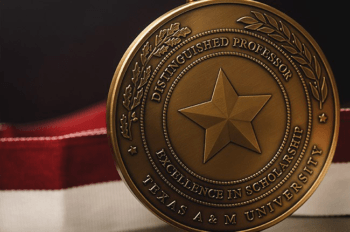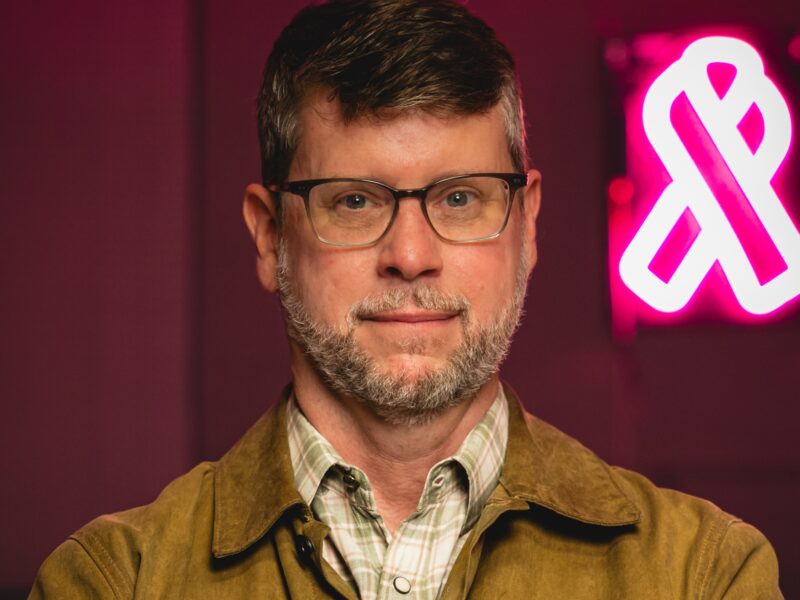Five Texas A&M Faculty Honored As University Distinguished Professors
 Five Texas A&M University faculty members have been appointed as university distinguished professors, effective Sept. 1. The title, which is bestowed in perpetuity, is awarded to a maximum of five faculty members each year.
Five Texas A&M University faculty members have been appointed as university distinguished professors, effective Sept. 1. The title, which is bestowed in perpetuity, is awarded to a maximum of five faculty members each year.
The latest recipients of the highest academic honor awarded to Texas A&M faculty are: Paul S. Cremer, professor of chemistry, College of Science; Christopher Layne, professor, George Bush School of Government and Public Service; David M. Lee, professor of physics, College of Science; Timothy D. Phillips, professor of veterinary integrative biosciences, College of Veterinary Medicine and Biomedical Sciences; and Guoyao Wu, professor of animal science, College of Agriculture and Life Sciences.
The 2012 university distinguished professor honorees join a select group of 64 current faculty members that hold the prestigious title. This designation denotes a faculty member who is recognized as being in the top 2 percent of active researchers in his or her field by peers in top-ranked academic institutions throughout the world.
“University Distinguished Professors represent the highest level of achievement for our faculty,” said Karan L. Watson, provost and executive vice president for academic affairs. “Their scholarship will have a lasting impact on their respective fields of study for many generations to come, and it demonstrates to the world the high quality of scholarship underway at Texas A&M University.”
The Texas A&M Foundation will host a reception on May 1 recognizing the five new university distinguished professors and honoring all of the distinguished professors. The foundation generously provides funding for the annual $5,000 bursary that each of the new university distinguished professors will receive for the next five years.
Paul S. Cremer
Paul S. Cremer, professor and holder of the Arthur E. Martell Chair of Chemistry, joined the Texas A&M faculty in 1998. He earned a B.A. from the University of Wisconsin at Madison and a Ph.D. from the University of California at Berkeley. He was an American Chemical Society Sigal Postdoctoral Fellow at Stanford University. Cremer has a national and international reputation in the field of biological surface science, which is considered to be one of the broadest, most interdisciplinary, and fundamentally important fields of chemistry and biology. Cremer’s work is key to unraveling the mysteries of why water is essential to making biology and life possible. The impact of this work will continue well into the future because his very fundamental studies of intermolecular interactions in biology and life are at the core of understanding how life works, how to improve the process for drug design, and how to think about toxicity. In addition to his novel contributions in research, Cremer is one of the youngest chemists to serve as an editor for the Journal of the American Chemical Society. He has also been honored with numerous awards, including the O’Donnell Award from The Academy of Medicine, Engineering, and Science of Texas and The Robert A. Welch Foundation Norman Hackerman Award in Chemical Research. He is a Fellow of the American Chemical Society and the American Association for the Advancement of Science.
Christopher Layne
Christopher Layne is professor and holder of the Robert M. Gates Chair in Intelligence and National Security at the George Bush School of Government and Public Service. He joined the Texas A&M faculty in 2007. He earned a B.A. in International Relations from the University of Southern California, a J.D. from the University of Southern California Law Center, an LL.M. in International Law from the University of Virginia Law School, a Diploma in Historical Studies from Corpus Christi College of the University of Cambridge, and a Ph.D. in political science (International Relations) from the University of California at Berkeley. He is recognized as a seminal contributor to the study of international politics and a leading scholar in the area of security studies, developing and applying theoretical explanations for the behavior of major states in international affairs. His creative scholarship has sparked several different widespread areas of inquiry among academics and generated invitations for dialogue within the United States government. Drawing on his theories, Layne has expanded his influence by providing insightful interpretations of current world events for the general public. He is the author of two books and has contributed extensively to the debates about international relations theory and American foreign policy in such scholarly and policy journals as International Security, Foreign Policy, The National Interest, and The Washington Quarterly, as well as to The Atlantic, The New Republic, The Nation, Financial Times, New York Times, Los Angeles Times, and Washington Post.
David M. Lee
David M. Lee, professor of physics and co-recipient of the 1996 Nobel Prize in Physics, joined Texas A&M’s Department of Physics and Astronomy in 2009 as part of the department’s condensed matter group. Lee also is the James Gilbert White Distinguished Professor of the Physical Sciences Emeritus at Cornell University. He earned a B.A. from Harvard, an M.S. from the University of Connecticut, and a Ph.D. from Yale. Lee has made many noteworthy discoveries during his more than 50-year career studying liquid and solid helium at low temperatures. He also was involved in studies of superconducting tunneling and in the discovery of nuclear spin waves in spin-polarized atomic hydrogen gas. Lee shared the 1996 Nobel Prize in Physics with fellow Cornell physicist Robert C. Richardson and Stanford University’s Douglas D. Osheroff for their 1972 discovery of superfluidity in helium-3 (He-3). As a result of their breakthrough discovery, superfluid He-3 is now one of the richest systems in condensed matter physics, with exotic order parameters that exemplify a whole new set of physical concepts that impact many other areas, including cosmology. During the course of their Nobel experiment, they also performed one of the first physics magnetic resonance imaging (MRI) experiments involving magnetic field gradients on the He-3 sample — imaging work applied to subsequent biological sampling techniques and later to the human body in disease detection and diagnosis. In addition to an in-demand international speaker, Lee has received numerous honorary degrees, and his students can be found on the faculties of the top universities and in top industrial positions around the world.
Timothy D. Phillips
Timothy D. Phillips is a professor of veterinary integrative biosciences in the College of Veterinary Medicine and Biomedical Sciences and a Texas AgriLife Senior Faculty Fellow, who holds the Chester Reed Endowed Chair in Toxicology. He earned a B.S. from Mississippi State University and an M.S. and Ph.D. from the University of Southern Mississippi. Phillips joined the faculty of Texas A&M University in 1979. During that time he also held adjunct positions with The University of Texas Medical Branch in Galveston and Texas Tech University in Lubbock. Since 2009, he has held a joint appointment with The Texas A&M University System Health Science Center School of Rural Public Health. During his 32-year career at Texas A&M, he has dedicated himself to: research with the potential to positively impact the health of infants and children in Africa; teaching what he has learned; and engaging in outreach that has resulted in meaningful relationships with people all over the world. Phillips’ major achievement is the development of a novel, easily disseminated, inexpensive way to remediate aflatoxin in staple foods, such as corn, peanuts, and rice, and thus prevent diseases associated with aflatoxicosis, including liver disease, liver cancer, malnutrition, and compromised immunity to infectious organisms. Aflatoxins are naturally occurring mycotoxins that are among the most toxic and carcinogenic substances known. As Phillips’ discoveries are increasingly implemented worldwide, the safety of the food supply will continue to improve for the 4.5 billion people of the world whose staple foods are contaminated with aflatoxin.
Guoyao Wu
Guoyao Wu is a professor of animal science and of nutrition, a Texas AgriLife Senior Faculty Fellow and a University Faculty Fellow. Wu has been a faculty member in the Department of Animal Science since 1991 and holds joint appointments with the Department of Medical Physiology in the Texas A&M Health Science Center College of Medicine and the Department of Veterinary Integrative Biosciences in the College of Veterinary Medicine and Biomedical Sciences He earned a bachelor’s degree in animal science from South China Agricultural University in Guangzhou, a master’s degree in animal nutrition from Beijing Agricultural University, and a master’s degree and doctorate in animal biochemistry from the University of Alberta in Canada. He received postdoctoral training at McGill University Medical School in Montreal, and the Memorial University of Newfoundland Medical School in St. John’s, Canada. Wu teaches graduate courses in protein metabolism and nutritional biochemistry. His research centers on protein and amino acid nutrition and metabolism, a vast field that straddles basic biology, agriculture and medicine. His discoveries relating to the essential role of amino acids have significantly changed the views of professionals in the global animal feed industry, veterinary medicine, human nutrition, and the pharmaceutical industry. In addition, Wu’s work on prevention and treatment of obesity, diabetes and fetal growth retardation has had major influence well beyond the bounds of normal amino acid metabolism. Wu is the author or co-author 348-papers and 47 book chapters. He is the recipient of a number of prestigious awards from China, Canada and the United States.
Media contact: tamunews@tamu.edu.





